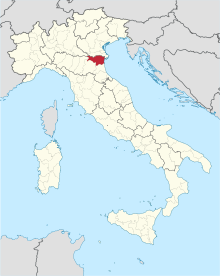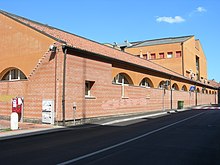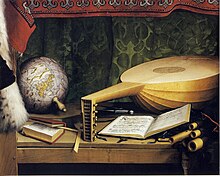Leonello d'Este, Marquis of Ferrara
| Leonello d'Este | |
|---|---|
| Marquis of Ferrara and Duke of Modena and Reggio Emilia | |

|
|
| Coat of arms |  |
| Spouse | Margherita Gonzaga: m. 1435-1439 Mary of Aragon: m. 1444-1450 |
| Noble family | House of Este |
| Father | Niccolò III d'Este |
| Mother | Stella de’ Tolomei |
| Born |
21 September 1407 Ferrara, Italy |
| Died | 1 October 1450 (aged 43) |
 |

The University of Ferrara Palace
|

The Liberal Arts College at the University of Ferrara
|

The Faculty of Medicine Building at the University of Ferrara
|

The College of Architecture Building at the University of Ferrara
|

An illustration from Angelo Decembrio's De Politia litteraria,it was first published in 1540 after he died.
|

The Ambassadors (1533), painting by Hans Holbein the Younger (1498-1543): this section of the painting depicts details of a globe and lute with two books.
|

The Singing Lion (1444), by Antonio di Puccio Pisanello.
|
Leonello d'Este (also spelled Lionello; 21 September 1407 – 1 October 1450) was Marquis of Ferrara and Duke of Modena and Reggio Emilia from 1441 to 1450. Despite the presence of legitimate children, Leonello was favoured by his father as his successor. In addition, his virtuous qualities, high level of education, and popularity among the common people as well as his formal papal recognition ultimately made him the most suitable heir.
Leonello had little influence over the Italian political landscape and aristocracy in Ferrara. Contrary to other prior d’Este family leaders, such as Azzo VII, Niccolò III, and Isabella d’Este, who had a drive for power and control, Leonello is recognized principally for his sponsorship of the arts, literature, and culture. Between the years of 1441-1450, his learned courts and developing knowledge assisted him in transforming the city of Ferrara. Under the guidance of Guarino Veronese, his humanist teacher, and with the approval of the commune, Leonello began the reformation, particularly, the University of Ferrara.
Leonello not only elevated the humanistic cultural movements during his rule, but it also influenced the political and artistic advancements of his successors. Leonello d’Este served as the precursor of the achievements in the history of the House of Este.
Leonello was one of three illegitimate sons of Niccolò d'Este III and Stella de' Tolomei. He received a military education under the condottiero Braccio da Montone, and was tutored by Guarino Veronese, later appointed professor at the University of Ferrara, who also instructed him on the traits of a desirable ruler and how to govern. In 1425, after the execution of his elder brother Ugo Aldobrandino, he was the sole heir of Niccolò. In 1435, he married Margherita Gonzaga on 6 February and was recognized as legitimate son by Pope Martin V. Margherita, who died in 1439, gave birth to a child, Niccolò, in 1438 (died in 1476). In late December 1441, he succeeded to his father's possessions after Niccolò's death in northern Italy.
...
Wikipedia

